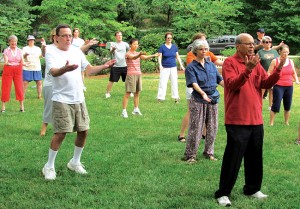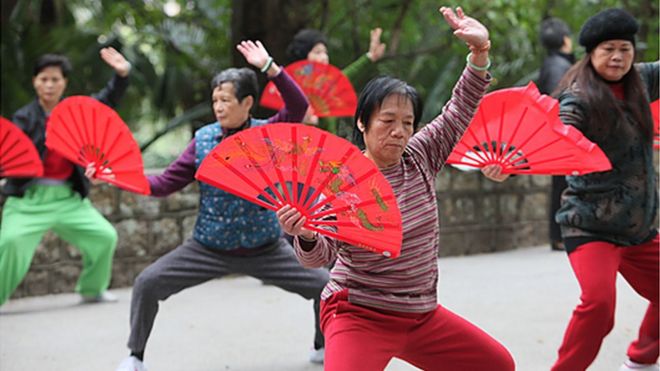Chinese exercises may improve cardiovascular health
American Heart Association Rapid Access Journal Report
March 09, 2016 Categories: Heart News
Study Highlight
Traditional Chinese exercises such as Tai Chi may lower blood pressure, improve cholesterol levels and quality of life and depression in patients living with heart disease and stroke.
Embargoed until 3 p.m. CT / 4 p.m. ET Wednesday, March 9, 2016
DALLAS, March 9, 2016 —Traditional Chinese exercises such as Tai Chi may improve the health and well-being of those living with heart disease, high blood pressure or stroke, according to new research published in the Journal of the American Heart Association.
“Traditional Chinese exercises are a low-risk, promising intervention that could be helpful in improving quality of life in patients with cardiovascular diseases — the leading cause of disability and death in the world,” said Yu Liu, Ph.D., study co-author, and dean of the School of Kinesiology, at Shanghai University of Sport in China. “But the physical and psychological benefits to these patients of this increasingly popular form of exercise must be determined based on scientific evidence.”
Chen Pei-Jie, Ph.D., the study’s lead author and president of Shanghai University of Sport in China and his team reviewed 35 studies, including 2,249 participants from 10 countries.
They found, among participants with cardiovascular disease, Chinese exercises helped reduce systolic blood pressure (the top number) by more than 9.12 mm Hg and diastolic blood pressure (the bottom number) by more than 5 mm Hg on average.
They also found small, but statistically significant drops in the levels of bad cholesterol (low-density lipoprotein) and triglycerides. Chinese exercises also seemed to improve quality of life and reduce depression in patients with cardiovascular disease. However, traditional Chinese exercises did not significantly improve participant’s heart rate, aerobic fitness level or scores on a general health questionnaire.
The review only analyzed studies which randomly assigned participants to groups performing traditional Chinese exercises (most commonly Tai Chi, Qigong and Baduanjin), engaging in another form of exercise or making no change in activity level.
note that although their review provided a good overview of the impact of traditional Chinese exercises on cardiovascular risk factors, several limitations: inclusion criteria varied across studies; participants were followed for a year or less; traditional Chinese exercises take many different forms and most results were evaluated by study leaders who knew which group participants had been assigned to, potentially biasing results.
Liu and his team have been studying the benefits of traditional Chinese exercises on a range of diseases for more than 5 years. They plan to conduct new randomized controlled trials to confirm the effect of different types of traditional Chinese exercises on chronic diseases.
Other co-authors are Xue-Qiang Wang, Ph.D.; Xin Li, M.Sc.; Bing-Lin Chen,M.Sc.; Yi Zhu, Ph.D.; Yu-Jie Yang, M.Sc.; and Zhan-Bin Niu, M.Sc. Author disclosures and funding information are on the manuscript.
Additional Resources:
Heart graphic, blood pressure cuff image, and cholesterol image are located in the right column of this release link
http://newsroom.heart.org/news/chine...b0e162da9db3f6
After March 9 view the manuscript online.
What is Cardiovascular Disease?
American Heart Association Recommendations for Physical Activity in Adults
Follow AHA/ASA news on Twitter @HeartNews.
For updates and new science from JAHA, follow @JAHA_AHA.
###
Statements and conclusions of study authors published in American Heart Association scientific journals are solely those of the study authors and do not necessarily reflect the association’s policy or position. The association makes no representation or guarantee as to their accuracy or reliability. The association receives funding primarily from individuals; foundations and corporations (including pharmaceutical, device manufacturers and other companies) also make donations and fund specific association programs and events. The association has strict policies to prevent these relationships from influencing the science content. Revenues from pharmaceutical and device corporations are available at
www.heart.org/corporatefunding.
For Media Inquiries and AHA/ASA Spokesperson Perspective: (214) 706-1173
Akeem Ranmal: (214) 706-1755;
akeem.ranmal@heart.org
Julie Del Barto (national broadcast): (214) 706-1330;
julie.delbarto@heart.org
For Public Inquiries: (800)-AHA-USA1 (242-8721)
heart.org and strokeassociation.org
Life is why, science is how . . . we help people live longer, healthier lives.





 Reply With Quote
Reply With Quote









